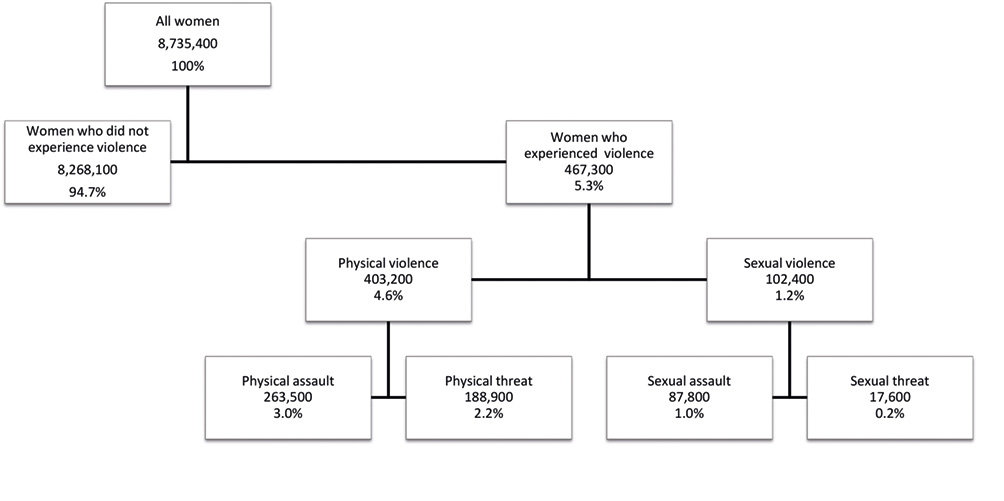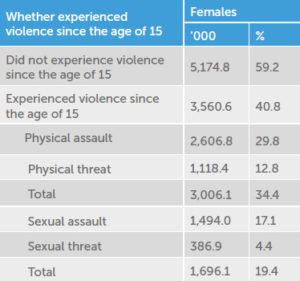Violence against women is a worldwide phenomenon affecting millions of people each year. A 2013 systematic review by WHO reported that 35 per cent of women had experienced physical and/or sexual violence from a partner or non-partner.1
In Australia, recent reliable estimates of the prevalence of violence against women can be obtained from the Australian Bureau of Statistics’ 2012 Personal Safety Survey (PSS), conducted from February to December 2012. This survey interviewed 17,050 randomly selected members of Australian households. Interviews were conducted privately, with interviewers trained specifically for what had the potential to be sensitive and traumatic disclosures. The results from this survey are expressed as estimates of the percentages and total numbers of women aged greater than 18 at the time of the survey. Data were collected both in terms of experiencing violence in the past 12 months, or at any time since the age of 15.
Women’s experience of violence in the past year
Figure 1 reproduces a flowchart summarising the prevalence estimate results of the PSS. The 2012 PSS data indicate that in the 12 months prior to the survey, 5.3 per cent of Australian women aged greater than 18 reported experiencing violence, 4.6 per cent experienced physical violence and 1.2 per cent experienced sexual violence.

Figure 1. Women’s experience of violence during the last 12 months, from ABS Personal Safety Survey, 2012.
Changes in prevalence of violence
The 2012 PSS results compared the prevalence of violence with results from previous surveys in 1996 and 2005. While there was a statistically significant decrease from 1996 to 2005 in the proportion of women aged 18 years and over who had experienced violence in the 12 months prior to the survey (from 7.1 per cent in 1996 to 5.8 per cent in 2005)2, there was no statistically significant change from 2005 to 2012 in the proportion of women who had experienced violence in the 12 months prior to the survey. In 2005, an estimated 5.8 per cent of all women had experienced violence in the 12 months prior to interview, compared to 5.3 per cent in 2012.2

Table 1. Estimated prevalence of women experiencing physical or sexual violence since the age of 15, extracted from ABS Personal Safety Survey, 2012.
Experience of violence by women any time since the age of 15
The PSS 2012 results estimated that 41 per cent of Australian women aged 18 and over (3,560,000 women in 2012) had experienced physical and/or sexual violence since the age of 15. Physical violence was experienced by 30 per cent of women (2,608,000) while 17 per cent (1,494,000) had been the victim of sexual assault since the age of 15.
Relationship to perpetrator of violence
Women who reported experiencing either sexual or physical violence since the age of 15 were much more likely to be assaulted by a person known to them than by a stranger. In the case of the 19.4 per cent of women who had experienced sexual violence, the perpetrator was known to the victim in 16.4 per cent of women and a stranger in 5.3 per cent. Current (4.9 per cent) or previous (4.4 per cent) partners, or boyfriend/girlfriend or date (5.9 per cent) were the highest reported relationships while 3.7 per cent reported being sexually assaulted by an acquaintance or neighbour and 1.6 per cent by a work colleague.
In the case of physical violence, of the 34.4 per cent of women who reported experiencing physical violence since the age of 15, in 8.4 per cent the perpetrator was a stranger and 29.6 per cent the perpetrator was known to them. Current (2.6 per cent) or previous (13.3 per cent) partners, or boyfriend/girlfriend or date (6.8 per cent) were again the highest reported relationships. 3.9 per cent reported being physically assaulted by an acquaintance or neighbour and 0.8 per cent by a work colleague.
Violence in pregnancy in Australia
A further analysis of the PSS data in 2015 reported that approximately 180,000 women experienced violence by a current partner and were pregnant at some time in that relationship. Of these women, 21.7 per cent reported experiencing violence while they were pregnant, and of these women, 61 per cent experienced violence for the first time during pregnancy.3
The same paper also reported data on 768,000 women who experienced violence during relationships with previous cohabiting partners, and were also pregnant at some time in that relationship. Of these women, 53.9 per cent reported experiencing violence while they were pregnant in these previous relationships, with 47 per cent of these women reporting that they experienced violence for the first time while they were pregnant.
Time off work
The 2012 PSS reported the number of women who took time off work in the 12 months following their most recent experience of domestic violence. Of the women who reported experiencing sexual assault by a male perpetrator since the age of 15, 10.9 per cent took time off work in the 12 months following their most recent assault, while 29.6 per cent did not work at all in that time, although that could not necessarily be attributed to the violent incident/s. The standard error in the data regarding sexual assaults on women by women was considered too large to be reliable. In the case of women experiencing physical assault since the age of 15 by a male perpetrator, 19 per cent took time off paid work in the 12 months following the most recent assault and 29.6 per cent did not work at all. In the case of females experiencing physical violence by female perpetrators the corresponding numbers were 5.1 per cent and 34.2 per cent respectively.4
Conclusion
While the prevalence of violence against women in Australia is impossible to precisely ascertain, the data presented in this summary highlight the high rates of violence against women, with 40 per cent of women reporting experiencing violence since the age of 15. Perpetrators of violence against women are far more likely to be known to them than be strangers, with a substantial number of women being the victim of violence while they were pregnant and missing work because of it. These data should alert readers to be vigilant to the possibility of violence occurring to the women they have contact with in their personal and professional lives.
References
- WHO, Department of Reproductive Health and Research, London School of Hygiene and Tropical Medicine, South African Medical Research Council. Global and regional estimates of violence against women: prevalence and health effects of intimate partner violence and non-partner sexual violence. WHO, Geneva, 2013.
- Australian Bureau of Statistics. 2013. 4906.0 – Personal Safety, Australia, 2012. www.abs.gov.au/ausstats/[email protected]/Latestproducts/4906.0Main%20Features12012?opendocument&tabname=Summary&prodno=4906.0&issue=2012&num=&view=.
- Cox, P. Violence against women in Australia: Additional analysis of the Australian Bureau of Statistics’ Personal Safety Survey, 2012. ANROWS, Sydney. 2015.
- Australian Bureau of Statistics. 2013. 4906.0 – Personal Safety, Australia, 2012. www.abs.gov.au/ausstats/[email protected]/Latestproducts/4906.0Main%20Features12012?opendocument&tabname=Summary&prodno=4906.0&issue=2012&num=&view=.






Leave a Reply